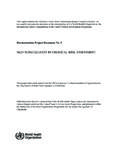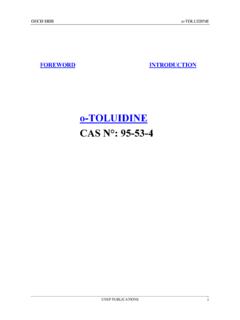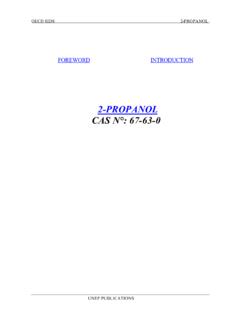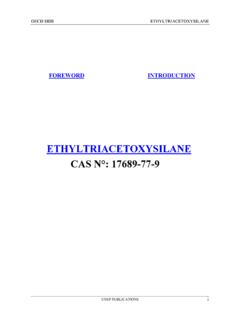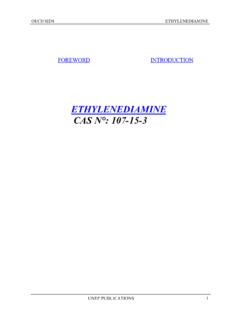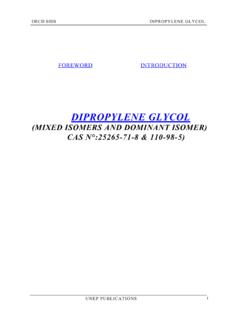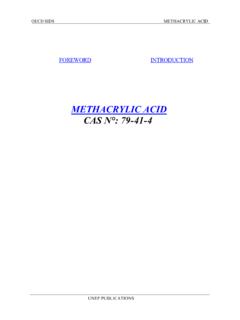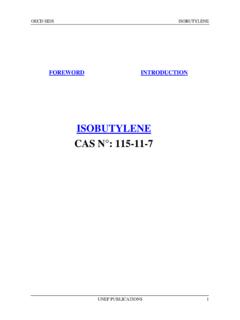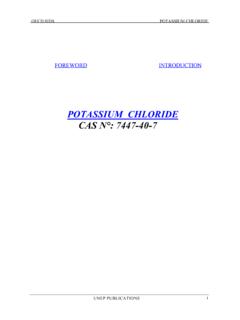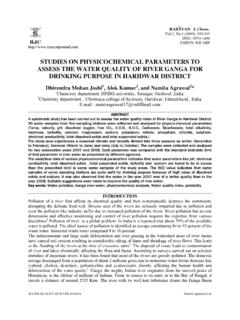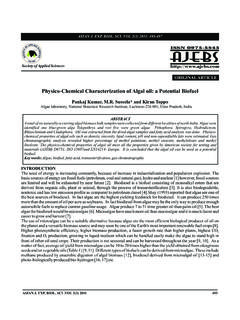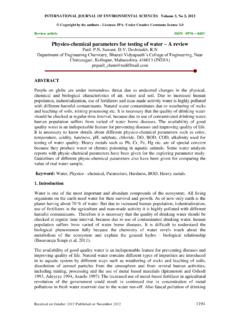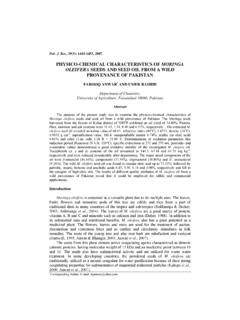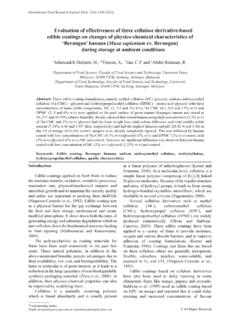Transcription of Methyl Acrylonitrile CAS N°:126-98-7 - IPCS INCHEM
1 OECD SIDS Methyl Acrylonitrile . FOREWORD INTRODUCTION. Methyl Acrylonitrile CAS N :126-98-7. UNEP PUBLICATIONS 1. OECD SIDS Methyl Acrylonitrile . SIDS Initial Assessment Report For SIAM 14. 26-28 March 2002, Paris, France 1. chemical Name: Methyl Acrylonitrile 2. CAS Number: 126-98-7. 3. Sponsor Country: Japan National SIDS Contact Point in Sponsor Country: Mr. Yasuhisa Kawamura, Ministry of Foreign Affairs, Japan 4. Shared Partnership with: 5. Roles/Responsibilities of the Partners: Name of industry sponsor /consortium Process used 6. Sponsorship History How was the chemical or The original draft documents were prepared by Japanese category brought into the government. OECD HPV Chemicals Programme ?
2 7. Review Process Prior to the SIAM: 8. Quality check process: 9. Date of Submission: Deadline for circulation: February 1, 2002. Date of Circulation: February 1, 2002. 10. Date of last Update: 11. Comments: No testing ( ). Testing (x) Vapor pressure, log Pow, Water solubility, Hydrolysis and Photolysis, Biodegradation, Environmental fate, Acute toxicity to fish, daphnia and algae, Chronic toxicity to daphnia, Acute toxicity, Combined repeated and reproductive/developmental toxicity, Ames test and Chromosomal aberration test 2 UNEP PUBLICATIONS. OECD SIDS Methyl Acrylonitrile . SIDS INITIAL ASSESSMENT PROFILE. CAS No. 126-98-7. chemical Name Methyl Acrylonitrile Structural Formula RECOMMENDATIONS.
3 The chemical is currently of low priority for further work. SUMMARY CONCLUSIONS OF THE SIAR. Human Health Methylacrylonitrile was readily absorbed through the gastrointestinal tract. It distributed to all tissues, but the potential for bioaccumulation was minimal. The main excretion route was expired air as carbon dioxide, which was saturable with increased dose. Metabolism and excretion of this chemical depend on the dosing vehicle and the species/strain. There are definite species differences in the acute toxicity. The oral LD50 was 64~240 mg/kg for rats, 17. mg/kg for mice, 16 mg/kg for rabbits and ~ mg/kg for gerbils. Clinical signs were decrease in locomotor activity, adoption of a prone and/or lateral position, and hyperpnea.
4 Inhalation LC50 of rats was also obviously higher than that of mice and rabbits although all these were reported in 1968. Clinical signs by inhalation were unconsciousness and tonic-clonic convulsions. This chemical is mildly irritating to skin and eyes in rabbits. In a human voluntary study, this chemical was also slightly irritating to respiratory tracts and eyes (even at 2 ppm (6 mg/m3) for 10 minutes). There is no available data on skin sensitization. Six oral and four inhalation repeated dose toxicity studies including two oral carcinogenic studies are available. Anemia and histopathological changes in olfactory epithelium and bone marrow were observed in rat oral studies. In addition, rats and mice at the higher doses showed clinical signs such as lethargy, tremors and convulsions.
5 In NTP 13-week studies, various effects including death were observed at mg/kg and more in rats, and at mg/kg in mice, showing significant species differences of the repeated dose toxicity. From a 2-year carcinogenicity study [NTP], the NOAEL for oral repeated dose toxicity was considered to be mg/kg for rats and mg/kg for mice. For inhalation exposure (90 days), the NOAEL was reported as ppm ( mg/m3) for rats and ppm ( mg/m3) for dogs although the data quality was not sufficient. This chemical was not mutagenic with and without an exogenous metabolic activation system in a bacterial test [OECD TG 471], while the cytogenetic effect was judged to be positive because of increases in mammalian cultured cells with structural chromosomal aberrations and polyploidy with an exogenous metabolic activation [OECD TG.]
6 473]. However, micronucleus tests by intraperitoneal injection to rats and mice or by gavage to mice showed negative results [NTP]. Therefore, a weight of evidence suggests that methylacrylonitrile may not be genotoxic in vivo. In 2-year gavage studies [NTP], this chemical did not cause any neoplastic changes in rats (up to mg/kg ) and mice (up to mg/kg ). Therefore, methylacrylonitrile was considered not to be carcinogenic in rodents. In an OECD combined study, there were no effects of this chemical on reproductive/developmental parameters even at the highest dose of 30 mg/kg In a two-generation study in rats, methylacrylonitrile did not affect the reproductive performance of both sexes, but induced a decrease of epididymal sperm density in the second UNEP PUBLICATIONS 3.
7 OECD SIDS Methyl Acrylonitrile . generation at 20 mg/kg At higher doses in rats (40 to 100 mg/kg ), prolonged estrous cycles were observed in an oral 13-week study and the pregnancy was not kept in an oral developmental study. In another developmental study in rats, there were no effects on fetal development up to 50 mg/kg by oral administration. Based on these results, the oral NOAEL for reproductive/developmental toxicity in rats was considered to be 7 mg/kg On the other hand, there was a decrease in the male/female ratio of fetuses/litter at a dose of 5 mg/kg in rabbits and a decreased body weight of fetuses was observed at 100 ppm by inhalation, probably due to maternal toxicity.
8 The NOAEL for developmental toxicity was 3 mg/kg in rabbits by oral administration, and 50 ppm in rats by inhalation. This chemical is not a teratogen. Environment Methyl Acrylonitrile is readily biodegradable and its bioaccumulation potential seems to be low based on its Log Pow ( ). In the air, this chemical is expected to be photodegraded (T1/2=about 46 hours). Hydrolysis is not expected to occur. A generic level III fugacity model shows that if methylacrylonitrile is released to one of the compartments of air, water and soil, it is unlikely to distribute into other compartments. Regarding the acute aquatic toxicity of this substance, the algal ErC50 of and EbC50 of mg/L are the lowest values among available data on species from three trophic levels.
9 Chronic toxicity NOEC values of 10 (growth rate) and (biomass) mg/L for algae are reported. The NOEC for daphnids is mg/L for reproduction. Exposure Methylacrylonitrile is a colorless liquid with acrid odor, which is soluble in water (29 g/L at 25 C). Its vapour pressure is x 103 Pa at 20 C. The production volume of Methyl Acrylonitrile in Japan was about 20,000 tonnes in 1998. This chemical is used as an intermediate in the preparation of methacryllic derivatives, and polymers. Exposure to this chemical via inhalation and dermal routes may be possible during handling of quality control samples, and tank lorry filling. Estimated exposure concentration for these operations is 10-50 ppm by EASE model, and EHEinh+der was mg/kg bw/day at the production site.
10 A TLV (TWA) of 1 ppm has been adopted in several countries. NATURE OF FURTHER WORK RECOMMENDED. This chemical is currently not a candidate for further work unless there is significant exposure. 4 UNEP PUBLICATIONS. OECD SIDS Methyl Acrylonitrile . SIDS Initial Assessment Report 1 IDENTITY. Identification of the Substance CAS Number: 126-98-7. IUPAC Name: Methyl Acrylonitrile Molecular Formula: C4H5N. Structural Formula: Synonyms: 2- Methyl -2-propenenitrile Isopropene Cyanide Isopropenylcarbonitrile Alpha-Methylacrylonitrile 2-Methylpropenenitrile 2-Cyanopropene MAN. Purity/Impurities/Additives Substance type: organic Physical status: liquid Purity: % w/w Physico- chemical properties Methyl Acrylonitrile is a colorless liquid with acrid odor, which is soluble in water (29 g/L at 25.)
